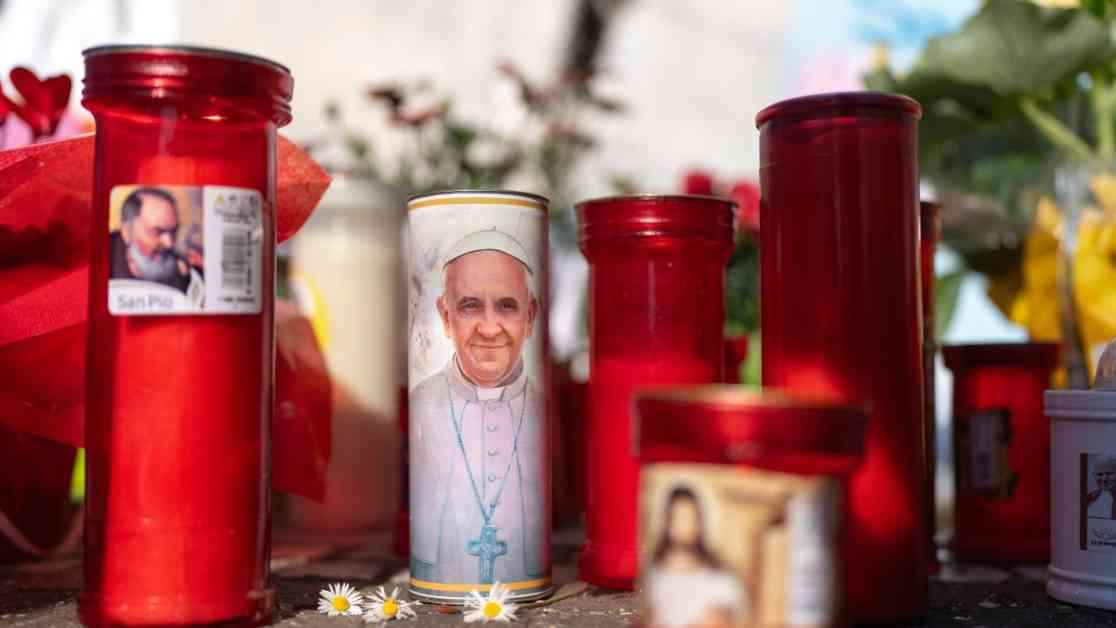Pope Francis Recovers from Respiratory Crisis: An Insightful Recovery
Pope Francis, at 88 years old, has been battling double pneumonia for over two weeks. The Vatican announced on Tuesday that he had shown enough stabilization to be taken off noninvasive mechanical ventilation. Instead, he was receiving high flows of supplemental oxygen as he continued his fight against the respiratory infection.
Waking up on Tuesday, Pope Francis resumed respiratory physiotherapy after a restful night’s sleep. Doctors confirmed that he no longer needed the mechanical ventilation mask, which had previously covered his nose and mouth to assist with pumping oxygen into his lungs. Instead, he was receiving supplemental oxygen through a nasal tube.
The critical turning point came after Francis experienced two respiratory crises that necessitated the extraction of significant amounts of mucus from his lungs. Medical professionals conducted two bronchoscopies, a procedure involving a camera-tipped tube inserted into his airways to remove fluid. This intensive treatment was required due to the accumulation of mucus, a common reaction to the original pneumonia infection. Fortunately, laboratory tests showed no signs of new bacteria, indicating that the mucus buildup was a response to the existing infection.
Concerning Developments and Expert Insight
Dr. John Coleman, a pulmonary critical care physician at Northwestern Medicine in Chicago, shed light on the severity of the situation. He expressed heightened concern over the recent respiratory episodes compared to the previous incident when Pope Francis experienced a coughing fit. The need for bronchoscopies to manually remove the mucus from his lungs indicated that his body was struggling to clear secretions independently. Coleman’s expert perspective underscored the challenges the Pope faced in improving his lung function, especially considering his limited physical activity, wheelchair use, and weight.
Coleman emphasized that the Pope’s fluctuating condition was evident through small steps forward followed by setbacks. Despite undergoing respiratory physiotherapy, the accumulation of secretions in his lungs suggested a lack of muscle tone necessary to expel fluids effectively. Noninvasive ventilation was employed to avoid intubation, a more invasive form of mechanical ventilation. Notably, Pope Francis had not required intubation during his hospitalization, raising questions about his advance directives for care in case of further decline.
A Moral and Ethical Perspective
From a Catholic perspective, Archbishop Vincenzo Paglia addressed the complex ethical considerations surrounding end-of-life care. He highlighted Pope Francis’ adherence to the teachings of the Catholic Church, which stress the sanctity of life from conception until natural death. While advocating for the provision of “ordinary” care, such as hydration and nutrition, the Church acknowledges the permissibility of suspending “extraordinary” or disproportionate interventions. This nuanced approach aims to respect the dignity of life while acknowledging the limitations of medical intervention.
Paglia emphasized the Pope’s embodiment of fragility, serving as a poignant reminder to prioritize care for the elderly. Through his hospitalization, Pope Francis exemplified the vulnerability inherent in human existence, urging compassion and support for one another. As the Pope’s hospital stay extended to 18 nights, comparisons were drawn to St. John Paul II’s prolonged hospitalizations, underscoring the challenges faced by aging religious leaders.
In conclusion, Pope Francis’ journey through respiratory illness offered a profound reflection on the intersection of medical treatment, ethical considerations, and the inevitability of human frailty. His recovery, marked by moments of progress and setbacks, served as a poignant reminder of the complexities inherent in healthcare decisions and the importance of holistic care for individuals at all stages of life.


